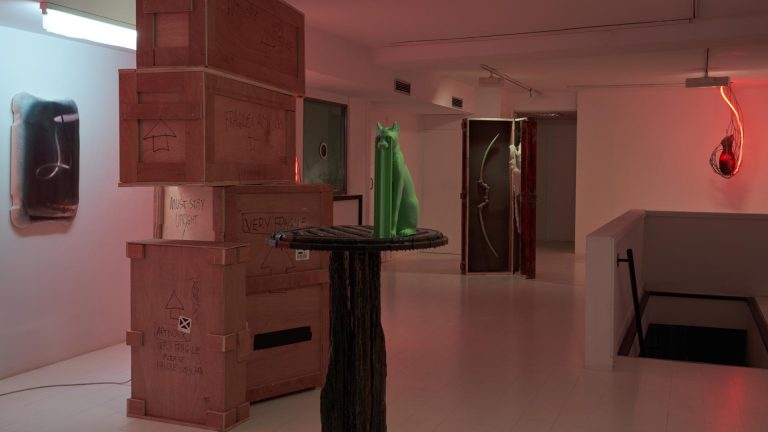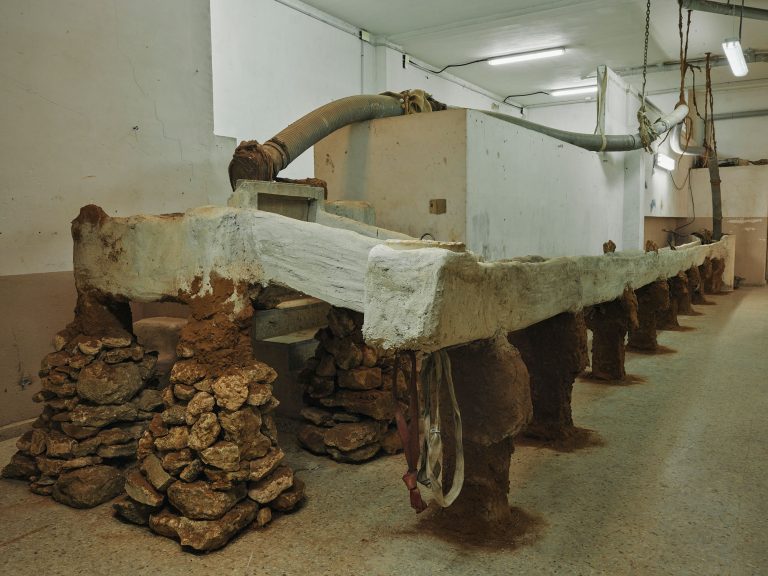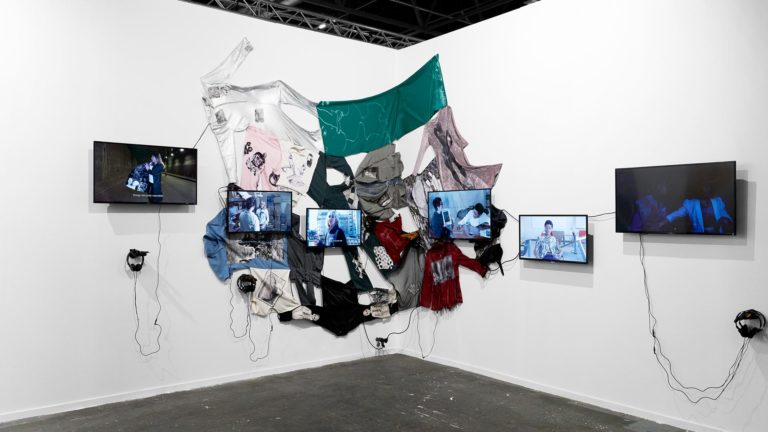Artists: Trisha Baga, Celia Hempton, Ana Martínez Fernández
Exhibition title: Fervor
Curated by: This is Jackalope
Venue: CIBRIÁN, San Sebastian, Spain
Date: July 22 – September 24, 2022
Photography: all images copyright and courtesy of the artists and CIBRIÁN, San Sebastian
“ That women understand one another’s language best, and that my sisters affection for me would make them pay special attention to my words.”
The Interior Castle, preface
Teresa of Ávila
Fervor proposes an exhibition set- up created around the work of three women artists. We present an itinerary intermingling remnants of stories in which intimacy enables us to address issues of memory, the body, relations, identity, the disruption of time and the nostalgia inherent to our contemporaneity.
The three artists gathered here work from the basis of the everyday gesture, applying diverse strategies to addressing this complexity. Vulnerability, ingenuity, intuition, poetry, honesty and science fiction are some of the manoeuvres with which they test new manners of formally coping with the day -to-day in conversation with the political with a clear intention of changing the ways in which the world functions from the closest experience. Intimacy is understood in many cases as a rich place of resistance, from which to decide and experiment with other ways of meeting, being, touching or moving one another.
Trisha Baga seeks to connect us with some of the myriad sensory layers of her works. Often in these works, Baga includes personal stories and objects, as well as friends who take part in her videos ; here little importance is lent to the narrative, but rather to our ability to connect with the genuine side of that daily life and how the strength they convey has the ability to move something inside us.
Totally mundane aspects, such as a car at night or a dog, combine with more surreal and ironic scenes, like Gore 2000, where a cup seems to melt before the scene of a fire ; functional ceramic lamps represent different chapters of a story where a UFO comes to Lesbos island. Science fiction is presented as a rich opportunity to tip the norm towards progress. Imagining other futures through exercises including the change of scale, space-time collapse, or the pre-eminence of emotion within the abstraction.
The series of paintings by Celia Hempton are based on everyday images, often mediated by technology (scenes viewed through chat random, CCTV cameras…). This is the case of Marian and Pakistan : extreme close-ups appear in both paintings, revealing the focus of the interlocutors’ camera. These are virtual meetings in which we are aware that the gaze is registered and monitored and where real identities are hidden, hence the relations established are complex, giving rise to imbalances and exchanges of power. Painting in this way enables Hempton to detach from or break down ‘the observed’ in such a way as to dissociate from its meaning and reference.
The palette of colours she cleverly uses is another tool that takes us away from a figurative image and leads us to the contemplation of a landscape, inducing us to a state of mind.
Ana Martínez Fernández presents three sculptures ; at first glance they are three more or less recognisable household items; two Venetian blinds and one hat. If we look more closely, the strips of both blinds have a common shape referring us to a similarly familiar object, a sports jacket by a popular brand. In Give up the ghost the blind has completely lost its functional nature ; it is the fabric-like strips themselves that are now translucent and allow us to see through them. As if identity and desire were not hidden, but had come timidly out into the light. She uses the subtlety of the possible hollows and spaces occurring in the context to find that feeling of belonging and draw strength from intimacy and ingenuousness.
On the other hand, in com/post_desgaste mud and net fabric lend opacity to these strips. They compose multiple layers of information, details and complex compositions. Present once again is the reference to a jacket sleeve that becomes the strip of a blind, without it being of any apparent use for concealment. What we see is not simply an “object” but myriad essences of objects that are no longer what they were due to having lost that functional nature, but from which their origin continues to seep through. Becoming something new from the essences of the past. Identity and desire are not easily sensed this time or perhaps they are felt more than ever.
The idea of uniting the work of Baga, Hempton and Martínez Fernández was born with the intention of turning the focus on the vulnerable and ordinary rather than the strong and the extraordinary. Lending a prominent place to these two concepts, traditionally portrayed as weak, is to recognise their importance in the world for what they are, a complex multiplicity of layers that enrich our ways of being and doing.







































